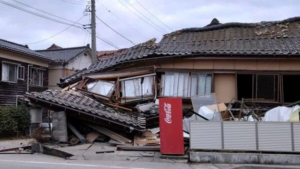Japan Earthquake:
On Monday, central Japan experienced a significant seismic upheaval with the occurrence of a powerful earthquake measuring a magnitude of 7.6. The Japan Meteorological Agency promptly responded to this Japan earthquake, issuing urgent tsunami warnings for the western coastal areas.
The swift reporting of the seismic activity by public broadcaster NHK heightened immediate concern, setting off a series of consequential events in response to the escalating situation.
The earthquake, with its epicenter in north central Japan, raised alarms of potential large waves along the Sea of Japan. This led to a series of impactful developments, including the evacuation advisories issued by authorities. The quake, with its magnitude of 7.6, rattled central Japan, setting off a chain of events that would unfold in the coming hours.
NHK reported that a tsunami, approximately one meter high, had already struck parts of the coast, forewarning of the expectation of larger waves in the near future. The Japan Meteorological Agency responded promptly, issuing tsunami warnings for the coastal prefectures of Ishikawa, Niigata, and Toyama. Residents were urged to stay alert and be prepared for possible evacuation, highlighting the potential danger posed by waves that could reach up to five meters.
The gravity of the situation was underscored by warnings from both the Hawaii-based Pacific Tsunami Warning Center and the Japan Meteorological Agency, emphasizing the need for immediate action and caution.
Meanwhile, a succession of 21 earthquakes, registering at a magnitude of 4.0 or stronger, struck central Japan in just over 90 minutes, with the strongest jolt measuring 7.6. This series of quakes prompted widespread tsunami warnings, compelling authorities to urge people in the affected area to move to higher ground.
The seismic event resulted in significant consequences, including power outages affecting more than 36,000 houses, closures of major highways, and the suspension of Shinkansen bullet train services between Tokyo and the earthquake’s epicenter in the Noto region.
Monitoring nuclear facilities became a critical aspect of the response, with Hokuriku Electric Power Company and Kansai Electric Power closely observing the situation. Reassuringly, the Nuclear Regulation Authority reported no irregularities at the Shika Nuclear Power Plant in Ishikawa Prefecture following the earthquake.
The aftermath witnessed a call for immediate action, as all residents were instructed to evacuate to higher ground. National broadcaster NHK conveyed this imperative message after the quake struck the Noto region in Ishikawa prefecture. Subsequently, Japan downgraded its ‘major Tsunami warning’ to a ‘Tsunami warning’ for the Noto region, reflecting the evolving nature of the situation.
The seismic event drew inevitable comparisons to the devastating earthquake and tsunami of March 11, 2011, which wreaked havoc in northeastern Japan, causing widespread destruction and nuclear meltdowns in Fukushima. The memory of this catastrophe remained fresh in the minds of many, contributing to the heightened urgency and caution in the current response.
As the situation continued to develop, residents were advised to stay informed through official channels and adhere to safety instructions issued by authorities. Ongoing monitoring and safety measures were paramount, with updates expected as agencies assessed the situation and responded to unfolding events.
The impact of the earthquake extended beyond Japan’s borders, as Russia’s emergencies ministry reported that regions along the western coast of Sakhalin Island were at risk of a tsunami. Evacuation measures were initiated for local residents. However, the tsunami threat from the massive earthquake was later declared to have largely passed by a US agency, following waves up to a meter high impacting certain locations earlier.
The repercussions reached South Korea’s Gangwon province, which, in the wake of the Japan earthquake, warned its residents to take precautions and evacuate to higher grounds. Even North Korea issued tsunami warnings for its east coast, anticipating waves of up to 2.08 meters, according to Yonhap news.
Tragically, the seismic event resulted in at least 30 reports of building collapses in Japan’s Ishikawa prefecture. One man lost his life after a building collapsed in Shika town, underlining the tangible and immediate impact of the earthquake.
Despite the lifting of the highest-level tsunami alert in Japan, coastal residents were cautioned not to return home due to the lingering risk of lethal waves. Transportation infrastructure took a hit, with forty train lines, including two high-speed rail services, halted, six expressways closed, and one of Ishikawa’s airports forced to shut down due to a runway break.
Japanese airlines, including ANA and Japan Airlines, adjusted flight routes and canceled services to affected regions. The situation remains dynamic, with ongoing monitoring and safety measures in place. As the events continue to unfold, residents and the global community await further updates from the authorities involved in managing the aftermath of this significant seismic event.
View this post on Instagram
Latest blog: New Year 2024: A Leap Year Celebration
जापान में 7.6 तीव्रता का भीषण भूकंप आयाअब जापान सुनामी अलर्ट पर है

1 thought on “Japan Earthquake: A massive quake of 7.6 magnitude in Japan prompts alarming tsunami alerts, necessitating urgent evacuations.”